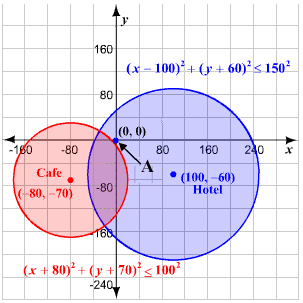
(a)
To determine : The inequalities for circular regions around the hotel and cafe in which the person can get wireless Internet access, taking the location of the person as the origin.
The inequalities for circular regions around the hotel and cafe in which the person can get wireless Internet access are
Given information :
A person is in a park surfing the Internet on a wireless connection. A hotel's wireless transmitter is located
Explanation :
The inequality used to describe the region inside a circle is
The range of the hotel’s wireless transmitter is
The hotel's wireless transmitter is located
So,
Thus, the inequality for circular regions around the hotel in which the person can get wireless Internet access will be,
The range of the cafe’s wireless transmitter is
The cafe's transmitter is located
So,
Thus, the inequality for circular regions around the cafe in which the person can get wireless Internet access will be,
Therefore, inequalities for circular regions around the hotel and cafe in which the person can get wireless Internet access are
(b)
To graph : The inequalities for circular regions around the hotel and cafe in which the person can get wireless Internet access, taking the location of the person as the origin.
Given information :
A person is in a park surfing the Internet on a wireless connection. A hotel's wireless transmitter is located
Graph :
The inequalities for circular regions around the hotel and cafe in which the person can get wireless Internet access are
Graph the inequalities.

Point A represents the place where the person is standing.
The distance of the person at
The distance of the person at
Interpretation :
The person is at a distance of
(c)
To explain : The way to determine the overlapping of regions.
To find that the regions overlap or not compare the sum of radius of the circular region in which the person can get wireless Internet access with the distance from the hotel’s transmitter to the cafe’s transmitter.
Given information :
A person is in a park surfing the Internet on a wireless connection. A hotel's wireless transmitter is located
Explanation :
Find the distance from the hotel’s transmitter to the cafe’s transmitter.
Compare it with the sum of the radius of the circular region in which the person can get wireless Internet access.
The distance from the hotel’s transmitter to the cafe’s transmitter is
Therefore, the regions overlap.
Chapter 8 Solutions
Holt Mcdougal Larson Algebra 2: Student Edition 2012
- Consider the table of values below. x y 2 64 3 48 4 36 5 27 Fill in the right side of the equation y= with an expression that makes each ordered pari (x,y) in the table a solution to the equation.arrow_forwardsolving for xarrow_forwardConsider the table of values below. x y 2 63 3 70 4 77 5 84 Fill in the right side of the equation y= with an expression that makes each ordered pari (x,y) in the table a solution to the equation.arrow_forward
- There were 426 books sold in one week. The number of biology books sold was 5 times that of the number of psychology books. How many books each were sold?arrow_forwardPopulation decreases 5% each year. Starts with a starting population of 3705. Find that population after 5 years.arrow_forwardsolve using substitution -2x-3y=-15 -3x+9y=12arrow_forward
- Suppose that 7000 is placed in an accout that pays 4% interest. Interest compunds each year. Assume that no withdraws are made. How much would the account have after 1 year? And how much would the account have after 2 years?arrow_forwardUse substitution to solve the equations -2x+5y=18 x=2y-8arrow_forward5) For each function represented by an equation, make a table and plot the corresponding points to sketch the graph of the function. (a) y = 75 ()* 220 X y 200- -2 180 160 -1 140 0 120 100 1 60 80 2 3 4 x (b) y = 20 ()* 1 60 40 20 20 0 2 3 65- -1 X y 60 -2 55- 50 45 44 40 0 35- 30 1 25 2 20 20 15 3 10 5 LO 4 3-2 T -1 0 5- 4- -3- 2-arrow_forward
- A system of inequalities is shown. y 5 3 2 1 X -5 -4 -3 -2 -1 0 1 2 3 4 5 -1- Which system is represented in the graph? Oy>-x²-x+1 y 2x²+3 -2 -3 тarrow_forwardWhich set of systems of equations represents the solution to the graph? -5 -4 -3 -2 Of(x) = x² + 2x + 1 g(x) = x²+1 f(x) = x²+2x+1 g(x) = x²-1 f(x) = −x² + 2x + 1 g(x) = x²+1 f(x) = x² + 2x + 1 g(x) = x²-1 -1 5 y 4 3 2 1 0 -1- -2 -3- -4. -5 1 2 3 4 5arrow_forwardWhich of the graphs below correctly solves for x in the equation -x² - 3x-1=-x-4? о 10 8 (0,2) -10 -8 -6 -2 2 4 6 8 10 (-4,-2) -2 + (0,2) (4,6) -10-8-6-4-2 -2 2 4 6 8 10 (-3, -1) -2 2 (1-5) -6 -8 -10 10 -10-8-6-4-2 2 6 8 10 (2,0)arrow_forward
 Algebra and Trigonometry (6th Edition)AlgebraISBN:9780134463216Author:Robert F. BlitzerPublisher:PEARSON
Algebra and Trigonometry (6th Edition)AlgebraISBN:9780134463216Author:Robert F. BlitzerPublisher:PEARSON Contemporary Abstract AlgebraAlgebraISBN:9781305657960Author:Joseph GallianPublisher:Cengage Learning
Contemporary Abstract AlgebraAlgebraISBN:9781305657960Author:Joseph GallianPublisher:Cengage Learning Linear Algebra: A Modern IntroductionAlgebraISBN:9781285463247Author:David PoolePublisher:Cengage Learning
Linear Algebra: A Modern IntroductionAlgebraISBN:9781285463247Author:David PoolePublisher:Cengage Learning Algebra And Trigonometry (11th Edition)AlgebraISBN:9780135163078Author:Michael SullivanPublisher:PEARSON
Algebra And Trigonometry (11th Edition)AlgebraISBN:9780135163078Author:Michael SullivanPublisher:PEARSON Introduction to Linear Algebra, Fifth EditionAlgebraISBN:9780980232776Author:Gilbert StrangPublisher:Wellesley-Cambridge Press
Introduction to Linear Algebra, Fifth EditionAlgebraISBN:9780980232776Author:Gilbert StrangPublisher:Wellesley-Cambridge Press College Algebra (Collegiate Math)AlgebraISBN:9780077836344Author:Julie Miller, Donna GerkenPublisher:McGraw-Hill Education
College Algebra (Collegiate Math)AlgebraISBN:9780077836344Author:Julie Miller, Donna GerkenPublisher:McGraw-Hill Education





